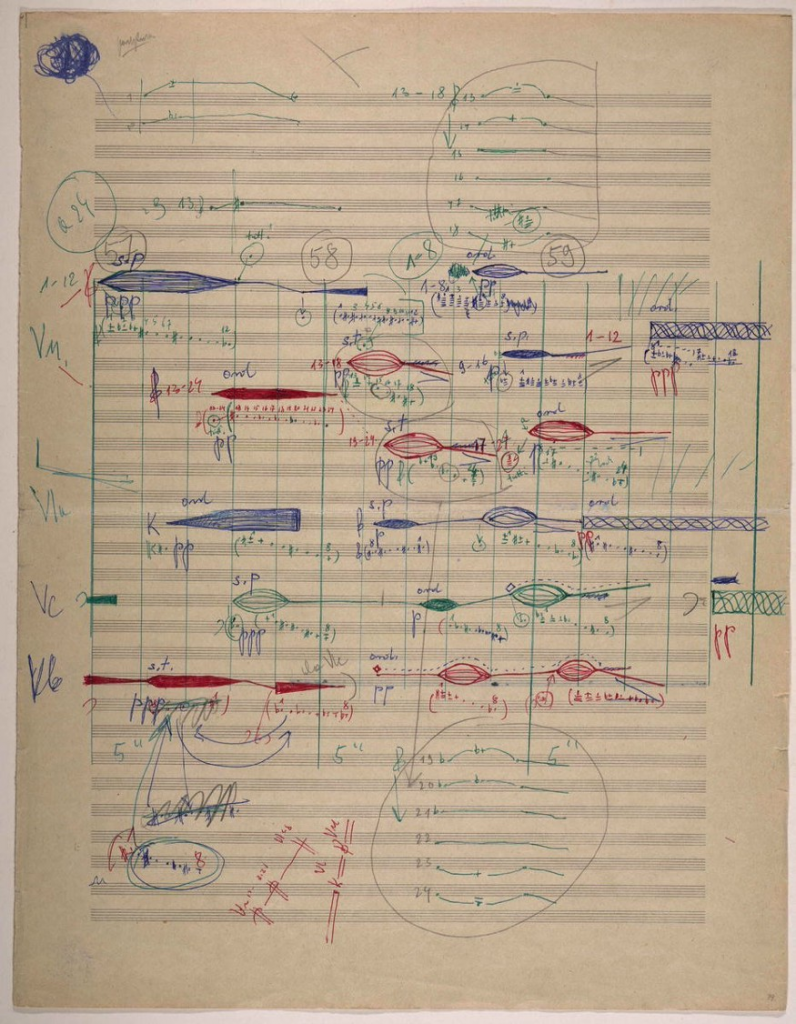A few days back, I felt like I was failing with nearly the entirety of the 2nd movement and was ready to scrap, a month-and-a-half in, the entire score. It was at ~13 minutes of music so I hadn’t listened to it in its entirety–just read through and listened to shorter sections as I worked or re-worked–and so it would have been easy for the cohesion to be in my head, not my ear. But after getting to what I planned to be the final two sections, I listened through for the first time and felt vindication and relief. My intent came through. (Although I can read and hear to a decent degree, I marvel at the modernist composers of the mid- and late-20th century who did not have software and who wrote–sometimes creating new notation in the process–some of the defining new orchestral sounds of our lives.)
This weekend I listened to Finnissy’s string quartet Multiple Forms of Constraint, Schnittke’s String Quartet No. 3, and re-listened to Penderecki’s Threnody. While researching I found out or re-found out that Penderecki died this year in March. That feels like living in the era in which Beethoven or the era in which Chopin died. I could have met him.


The Finnissy quartet (1997) and the Schnittke quartet (1983) together are a study in how postmodern compositional style has advanced. Schnittke’s work sounds like Schubert laid next to Schoenberg. He’s not quoting styles but more using them as a palimpsest and writing his music on top of them. This makes the flux between the two impulses more fluid and not so “cubist”. His is a very familiar postmodernism. Finnissy on the other hand goes further, or further in a cubist sense, but is no less fluid. His contrasts are metric and harmonic (1st violin against the three others) with various moments of “meta” interruptions. Not only do the two groups (violin and trio) seem to exists in different worlds–taking us outside of the music–the trio is interrupted periodically with a record-player-needle jarring scraped, sul ponitcello tremolos on the cello who is then left out for the final few minutes. Although I’m a fan of Schnittke, the Finnissy (14 years later) feels more relevant.
Performed at the CFA Concert Hall on March 27, 2015.
Ivana Jasova, violin
Janny Joo, violin
Sam Kelder, viola
Stephen Marotto, cello
The next part of the symphony I’ll be working on is a short interlude between the 2nd and 3rd movements titled Everything was forever until it was no more. I’ve been working with sonorist ideas for these first two movements (carried on from working out those ideas in the last few 2020 orchestral studies), thus the Penderecki. My plan is to make the interlude a pastiche of a Baroque orchestral suite. In preparation I’ve been listening to Schnittke and Finnissy and re-reading the Brandenburg Concerto score. This will be new territory that has a risk of coming off as kitch, and of course a risk of just mimicking my research composers. I’ll repeat the Picasso quote I found recently: “To copy others is necessary but to copy oneself is pathetic.”
